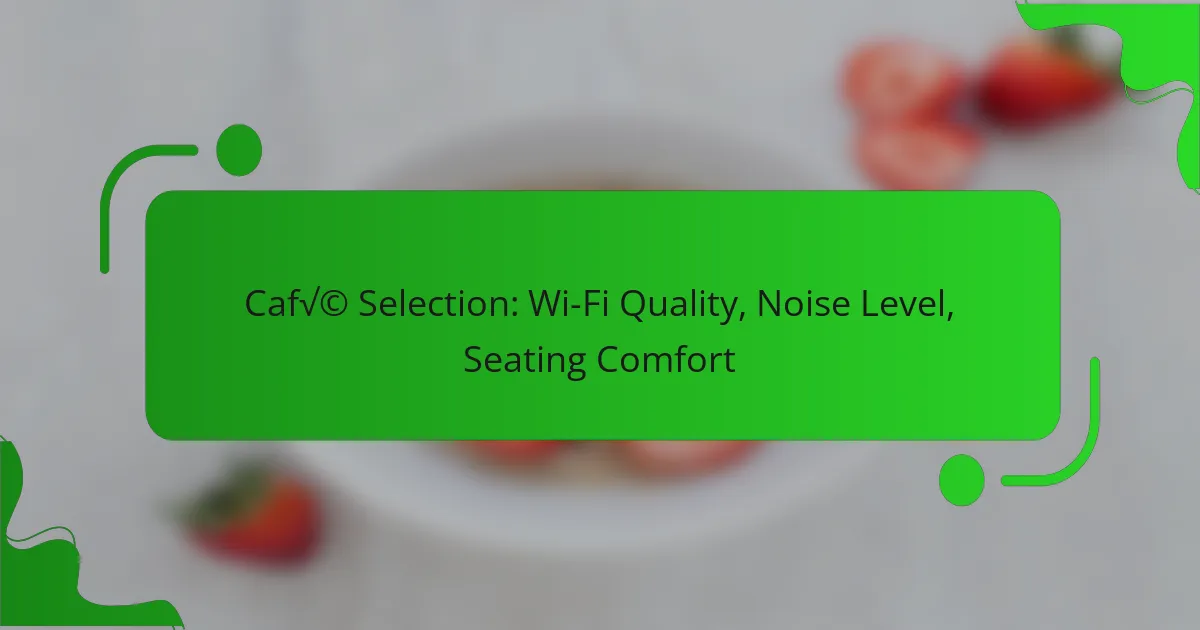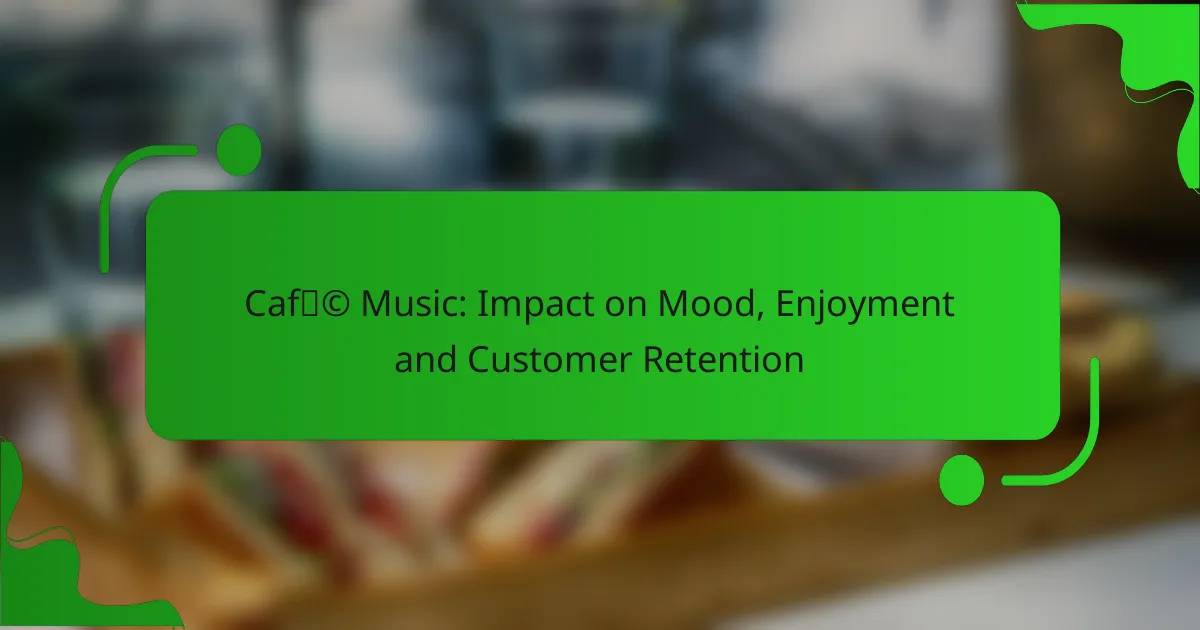The latest café design trends highlight a harmonious blend of aesthetic appeal, functionality, and innovation, aiming to create inviting spaces that enhance the customer experience. By focusing on modern elements and sustainable practices, these designs not only attract patrons but also foster a welcoming atmosphere that encourages them to linger and enjoy their time.

What are the latest café design trends in major cities?
The latest café design trends in major cities emphasize a blend of aesthetic appeal, functionality, and innovation. These trends focus on creating inviting spaces that enhance customer experience while incorporating modern elements and sustainable practices.
Biophilic design elements
Biophilic design integrates natural elements into café spaces, promoting a connection with nature. This can include features like living walls, indoor plants, and natural light, which enhance the ambiance and improve air quality. Cities like Melbourne and Amsterdam are leading this trend, with many cafés adopting greenery to create a calming atmosphere.
To implement biophilic design, consider using materials like wood and stone, and ensure ample windows for natural light. A small indoor garden or potted plants can significantly enhance the space without requiring extensive renovations.
Minimalist aesthetics
Minimalist aesthetics focus on simplicity and functionality, often featuring clean lines and a limited color palette. This trend is popular in urban areas where space is at a premium, allowing cafés to create a serene environment that encourages relaxation. Think of Scandinavian-inspired designs with neutral tones and uncluttered spaces.
When adopting a minimalist approach, prioritize essential furniture and decor. Choose multi-functional pieces that save space, such as stackable chairs or foldable tables, to maintain an open feel.
Flexible seating arrangements
Flexible seating arrangements cater to diverse customer needs, allowing cafés to accommodate individuals, small groups, or larger gatherings. This trend often includes movable furniture and varied seating options, such as communal tables, lounge areas, and bar seating. Cities like New York and London are embracing this adaptability to enhance customer flow and comfort.
To create flexible seating, invest in lightweight furniture that can be easily rearranged. Consider incorporating a mix of seating styles to appeal to different preferences, ensuring that the layout can be adjusted based on peak hours or special events.
Local art integration
Integrating local art into café design not only supports local artists but also creates a unique identity for the space. This trend involves displaying artwork from nearby creators, which can include paintings, sculptures, or even murals. Many cafés in cities like San Francisco and Berlin use art to reflect the local culture and community.
To effectively integrate local art, collaborate with local artists for rotating exhibitions or permanent installations. This not only beautifies the space but also fosters a sense of community and encourages repeat visits from locals and tourists alike.
Smart technology usage
Smart technology is increasingly being incorporated into café design to enhance customer experience and operational efficiency. This includes features like mobile ordering, contactless payments, and smart lighting systems that adjust based on occupancy. Major cities are seeing cafés adopt these technologies to streamline service and improve customer satisfaction.
When implementing smart technology, ensure that it aligns with your café’s overall design and enhances the user experience. Consider investing in a robust Wi-Fi network and user-friendly apps to facilitate seamless interactions for customers.

How can aesthetic appeal enhance customer experience?
Aesthetic appeal significantly enhances customer experience by creating an inviting environment that encourages patrons to linger and enjoy their time. A well-designed café not only attracts customers but also influences their mood and satisfaction, leading to repeat visits and positive word-of-mouth.
Inviting atmospheres
Creating an inviting atmosphere is crucial for any café aiming to attract and retain customers. Elements such as warm lighting, comfortable seating, and pleasing color schemes can make a space feel welcoming. Consider incorporating natural elements like plants or water features to enhance the ambiance further.
Additionally, the use of background music can set the tone, but it should be at a volume that allows for conversation. Striking a balance between lively and relaxing is key to fostering an inviting atmosphere.
Visual branding through design
Visual branding is essential for establishing a café’s identity and can be effectively communicated through design choices. This includes the café’s logo, color palette, and overall decor style, which should reflect the brand’s values and target audience. For instance, a modern café might use sleek furniture and minimalist decor, while a rustic café could incorporate vintage elements and wooden accents.
Consistent branding across all visual elements, from menus to signage, helps create a cohesive experience that customers can easily recognize and remember. This recognition can lead to increased loyalty and customer retention.
Comfortable layouts
A comfortable layout is vital for ensuring that customers feel at ease while enjoying their time in the café. Arranging seating to allow for both social interaction and privacy can cater to different customer needs. Consider offering a mix of communal tables and cozy corners to accommodate various group sizes and preferences.
Additionally, ensure that pathways are clear and that tables are spaced adequately to avoid overcrowding. This not only enhances comfort but also improves the overall flow of service, making it easier for staff to attend to customers efficiently.

What functional aspects should be considered in café design?
When designing a café, key functional aspects include efficient workflow layouts, accessibility features, and the use of durable materials. These elements ensure that the café operates smoothly while providing a welcoming environment for customers.
Efficient workflow layouts
An efficient workflow layout is crucial for optimizing staff productivity and enhancing customer service. Consider arranging the kitchen, service area, and seating in a way that minimizes movement and reduces wait times. For example, placing the coffee station near the entrance can streamline the ordering process.
Incorporate designated zones for different activities, such as food preparation, serving, and cleaning. This separation helps maintain order and efficiency, allowing staff to focus on their tasks without unnecessary interruptions.
Accessibility features
Accessibility features are essential to ensure that all customers can enjoy the café experience. This includes providing wheelchair-accessible entrances, seating, and restrooms. Following local regulations, such as the Americans with Disabilities Act (ADA) in the U.S., can guide your design choices.
Additionally, consider incorporating features like braille menus and clear signage to assist visually impaired customers. Ensuring that pathways are clear and furniture is arranged to accommodate mobility aids will create a welcoming atmosphere for everyone.
Durable materials
Choosing durable materials is vital for maintaining the café’s aesthetic appeal and functionality over time. Opt for surfaces that can withstand heavy use, such as high-quality laminate or solid wood for tables and chairs. These materials not only enhance the café’s look but also reduce long-term maintenance costs.
Incorporate materials that are easy to clean and resistant to stains, especially in high-traffic areas. For flooring, consider options like tile or sealed concrete, which can endure spills and foot traffic while providing a stylish finish.

How does innovation influence café design?
Innovation significantly impacts café design by introducing new materials, technologies, and architectural styles that enhance both aesthetic appeal and functionality. These advancements help create inviting spaces that attract customers while improving operational efficiency.
Use of sustainable materials
The use of sustainable materials in café design is becoming increasingly important as consumers prioritize eco-friendly practices. Materials like reclaimed wood, bamboo, and recycled metals not only reduce environmental impact but also add unique character to the space.
When selecting sustainable materials, consider their durability and maintenance requirements. For example, bamboo is both strong and lightweight, making it an excellent choice for furniture, while recycled metals can be used for fixtures and accents.
Incorporation of technology
Incorporating technology into café design enhances customer experience and operational efficiency. Features like mobile ordering systems, contactless payment options, and digital menus streamline service and cater to tech-savvy patrons.
Additionally, consider integrating smart lighting and climate control systems to create a comfortable atmosphere while optimizing energy usage. For instance, using LED lighting can reduce energy costs and extend the lifespan of fixtures.
Unique architectural styles
Unique architectural styles can set a café apart from competitors and create a memorable experience for customers. Styles such as industrial, minimalist, or rustic can influence the overall ambiance and attract different clientele.
When choosing an architectural style, think about how it aligns with your brand identity. For example, an industrial design featuring exposed brick and metal can appeal to a younger audience, while a cozy, rustic style may attract families looking for a warm environment.

What are the key criteria for selecting a café design?
Key criteria for selecting a café design include understanding the target audience, recognizing location-specific trends, and considering budget constraints. These factors help create an inviting atmosphere that meets customer expectations while ensuring operational efficiency.
Target audience preferences
Identifying the preferences of your target audience is crucial for effective café design. Consider factors such as age, lifestyle, and dining habits to create a space that resonates with them. For example, younger customers may prefer vibrant colors and communal seating, while older patrons might favor quieter, more intimate settings.
Engaging with potential customers through surveys or social media can provide insights into their likes and dislikes. This feedback can guide decisions on furniture, decor, and layout to enhance the overall experience.
Location-specific trends
Location plays a significant role in shaping café design trends. Urban areas may lean towards modern aesthetics with minimalistic furniture, while rural cafés might embrace rustic designs that reflect local culture. Understanding the demographics and lifestyle of the area can help tailor the design to fit the community’s character.
Additionally, keeping an eye on local competitors can reveal popular design elements that attract customers. For instance, if nearby cafés feature outdoor seating, incorporating a similar element could enhance your café’s appeal.
Budget considerations
Budget is a critical factor when selecting a café design, as it influences every aspect from layout to materials. Establish a clear budget range early in the planning process to avoid overspending. Consider allocating funds for essential elements like furniture, lighting, and decor, while also leaving room for unexpected expenses.
To maximize your budget, prioritize high-impact areas such as the entrance and seating arrangements. Opt for versatile furniture that can be rearranged for different events or peak hours. Additionally, consider sourcing materials locally to reduce shipping costs and support the community.



